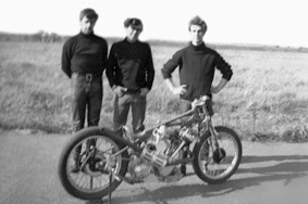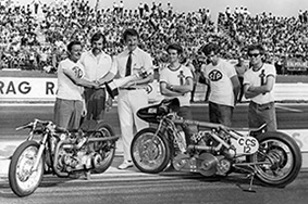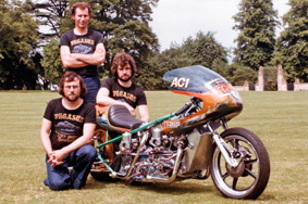
In The Beginning
Derek Chinn, Mick Butler and Ian Messenger were friends from Bedfordshire who shared a passion for motor cycles in the "Mods & Rockers" era of 1960's Britain. It was about the time when Santa Pod had just opened its gates to the unsuspecting British public. Our three intrepid heroes were instantly hooked after witnessing the late-great EJ Potter "The Michigan Madman" perform one of his extraordinary runs over the quarter mile aboard (just) his Chevy Corvette powered motorcycle. This spectacle, and a visit by Ian to the "Dragfests" a year or so earlier, convinced the guys this was a path in life they wanted to take.
With all three taking turns to ride, their initial entry into the rarefied world of Sprinting & Drag Racing in 1967 was powered by a 30 year old 600cc single cylinder Panther "Sloper" engine, usually employed in sedate motorcycle & sidecar combinations. Although not challenging the established stars of the day, "Long Rod" as it was christened, did muster a 13sec quarter - faster at the time than an E-Type Jaguar! The bike is still raced today at Sprint meetings by current owner Colin Jefferies, who has renamed it Pegasus-Panther in honour of its pedigree.
This experience focused their minds; it was time to get serious, they sold their beloved road bikes, pooled their resources and "Team Pegasus" was born. The fact that Derek was employed as an apprentice at Cranfield College of Aeronautics had the added bonus that certain "resources" could be diverted to the new project. In effect, the British Government became their first sponsor - albeit unknowingly!
At the outset in 1968 a normally aspirated 998cc V-twin Vincent engine was chosen, but it soon became apparent to make "real" horsepower the addition of a supercharger was needed. Inspired by the likes of George Brown, John Lloyd & Ian Ashwell, in 1969 the team débuted their first blown Pegasus machine. Again entrusting the V-twin Vincent engine for power and housed in a tubular frame constructed at Cranfield.

Success At Last
After a series of modifications and improvements, including the addition of an outside flywheel (later abandoned), the Pegasus-Vincent went on to record 9.83sec at 150mph for the quarter mile, garnering three British Championships (BDR&HRA + NDRC) and numerous event wins on the way. Also providing the spectacle of tyresmoke filled duels with rivals John Hobbs and Denis Norman amongst others. Although in 1970 a record terminal speed of 164mph credited to Ian was later deemed invalid as the front wheel lifted through the timing beams to give a false speed.
However in 1970, another memorable moment arose when they were invited by NHRA to compete in the US Nationals at Indianapolis along with Dennis "Stormin" Norman, whom they had raced with successfully in Sweden the year before. This was a "first" for a British team to compete at an NHRA national event.
Unfortunately this adventure did not have a fairy tale ending; with the bikes arriving two days late for qualifying this left precious little time to dial-in a set-up for such unusual conditions (for them) and Pegasus failed to qualify. The Teams had to be content to receive the "Long Distance" award on the Indianapolis start line - not the outcome they had hoped for. The award was later presented to Bob Phelps (owner of Santa Pod Raceway at the time) in recognition for his financial assistance in making the trip possible.
All this disappointment was soon forgotten with 1971 proving to be one of the most successful years for the team with all three members winning at least one event. Derek took the BDR & HRA British Championship with the whole team winning the NDRC Championship. This success gained the attention of Dave Riswick from John Woolfe Racing who agreed a limited sponsorship deal for 1972, this lead to Ian being employed by the famous Bedfordshire parts distributor
This turn of events however, was soured by continued reliability problems at the annual "World Record" meetings in Elvington. Despite numerous attempts Pegasus was never able to attain a record, something to this day that still rankles with the team although Mick Butler was successful with his own 500cc Norton.
By late 1972, with Derek's engineering expertise, the trusty Vincent engine had been bored & stroked to 1458cc. - although never raced. This was motivated by seeing the large capacity Harleys on their trip to the Indy Nationals. However, ultimately this proved unsuccessful as the rest of the machine was beginning to show its age and the decision was made to sell the bike and concentrate on building a "modern" replacement. At the same time, in an amicable split, Mick Butler decided he wanted independence to pursue his own racing venture.

End Of A Dream
With Derek and Ian encouraged by the achievements of TC Christenson's "Hogslayer" double engine Norton in the States, it was decided to use two Norton engines each with its own supercharger for the new Pegasus-Norton. As the project was gaining momentum the reduced Team Pegasus had a major breakthrough in the sponsorship department with EMAP's "Bike" magazine coming in as primary backer.
After a thoroughly disappointing début year of 1974 with many breakages, the next year proved much more successful. This cumulated in three consecutive Top Fuel Bike wins (known as Top Bike in those days), beating their arch rival & friend John Hobbs on a number of occasions and ending the year with best of time of 9.15sec/155mph. Joining Ian & Derek now was Eddie Keightly, a long standing friend whose help and dedication on race weekends was invaluable.
With all this publicity generating a higher profile, Pegasus was for the second time in it's history, featured in a prominent position at the annual International Motorcycle Show at Earls Court.
After a major upgrade in equipment, mainly a Lenco two speed transmission plus a Miller & Baskerville slider clutch. The peroid 1976 through to 1978 saw continued improvements and success with Pegasus running regular mid eights at around 165mph and taking other wins including two at the prestigious BDR & HRA "Supernationals". Much to the consternation of their fellow competitors, Team Pegasus also managed a virtual lock-out on the "Best Engineered or Best Appearing Machine" awards on offer.
However the tide was beginning to turn in favour of multi-cylinder single engine bikes in the form of the Late Henk Vink's "Big Spender" blown Kawasaki, which Derek & Ian were never able to beat in open competition despite going on to return a best time of 8.39sec at 170mph.
Alas, all good things have to come to an end; after enduring miserable 1979 & 80 seasons, with funds and time at a premium, Derek & Ian decided to place Pegasus in the National Motor Cycle Museum, Birmingham in order to pursue their respective careers at the time. Derek with his engineering company and Ian as Marketing Director for John Woolfe Racing. Like racers the world over, Derek & Ian believe their bike never reached its full potential for one reason or another, whether it would have run in the "sevens " is a matter for conjecture.
Completing the final chapter of this story, in the late 1980's Derek decided to build a replica of the unsupercharged Pegasus-Vincent campaigned by the three original team members during the 1968 season. After competing mainly in Sprints, Derek eventually hung up his leathers for good in 1995 and handed the riding chores over to Graham Martin, one of his employees. They now make an appearance at the annual "Dragstalgia" event, bringing the name of Pegasus full circle.
Bringing this up to date in 2013, Mick Butler retired a few years ago as a Fuel Route System Engineer from the Sizewell A nuclear power station in Suffolk. Ian also retired from his long-term occupation as a Commercial Photographer in 2012 while Derek continues to run his engineering company, Derek Chinn Precession Engineering, specialising in supplying superchargers & components to the historic sports car fraternity.
Update: Derek retired to Dorset after closing his business in 2020.